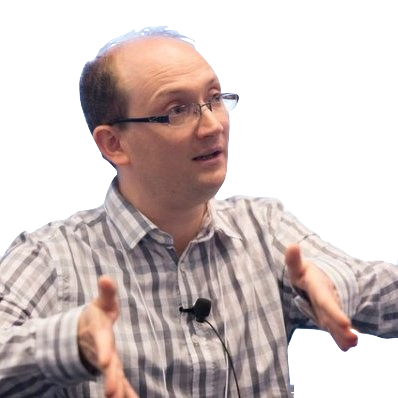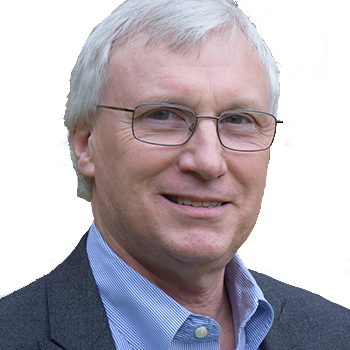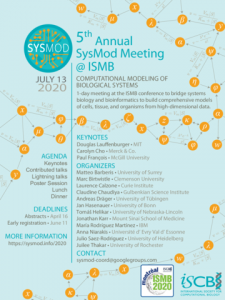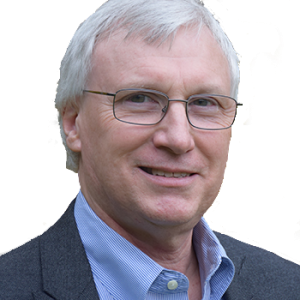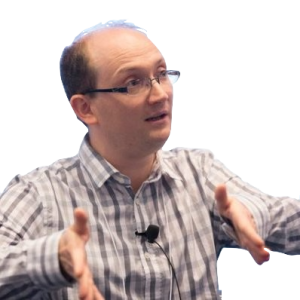Overview
Advances in genomics are creating new opportunities to understand the biology that require both systems modeling and bioinformatics. The fifth annual SysMod meeting will be a forum for discussion about the combined use of systems biology modeling and bioinformatics to understand biology, and disease. The meeting will take place on July 13, 2020, during the 2020 ISMB conference in Montréal, Canada. The meeting will feature several keynote talks and contributed presentations.
Topics
Methods
Dynamical modeling
Flux balance analysis
Logical modeling
Network modeling
Stochastic simulation
…
Systems
Animals
Bacteria
Humans
Plants
Yeast
…
Applications
Bioengineering
Cancer
Developmental biology
Immunology
Precision medicine
…
General information
Key dates
| Call for Abstracts Opens (for talks and posters) |
Thursday, January 30, 2020 |
| Abstract submission deadline (for talks and posters) |
Thursday, April 16, 2020 |
| Abstract acceptance notification |
Thursday, April 30, 2020 |
| Late poster submissions deadline | Thursday, May 14, 2020 |
| Late poster acceptance notifications | Thursday, May 21, 2020 |
| Early registration deadline | Thursday, June 11, 2020 |
| ISMB/ECCB conference | Sunday-Thursday July 12-16, 2020 |
| SysMod meeting | July 13, 2020 |
Abstract submission
We will accept abstracts for contributed oral presentations and posters. Abstracts should briefly (approximately 200 words) summarize the background/motivation, methods, results, and conclusions of your study.
For consideration for an oral presentation or poster, please submit your abstract via ISMB online system by April 16, 2020.
For consideration for a late poster presentation, please submit your abstract via ISMB online system by May 14, 2020.
Registration and fees
Please register for the SysMod meeting through the ISMB conference registration . Detailed information will be available starting March, 2020.
Scholarships
We intend to provide a small number of travel scholarships to students and postdocs.
Accommodations
Accommodations will be available through the ISMB conference. Please see the ISMB website for more information.
More information
For more information, please contact the SysMod coordinators 🔗.
Schedule
Day 1 – July 13th
Poster presentation
| 9:30-10:30 | ISMB Distinguished Keynote |
|---|---|
| 10:35-11:40 | Session I: Topic Moderator: Anna Niarakis, GenHotel, Univ Evry, Université Paris-Saclay, France |
| 10:35-10:40 | Introduction to SysMod 2020 Laurence Calzone Institute Curie, Parise, France Content |
| 10:40-11:00 | Maintenance energy is essential for accurate predictions of intracellular fluxes in CHO Diane Széliová University of Natural Resources and Life Sciences, Vienna Chinese Hamster Ovary (CHO) cells are the most valuable mammalian cell hosts for the production of complex protein biopharmaceuticals. Currently, cell line and bioprocess development must be done individually for each new product and rely mostly on trial and error approaches and screening of thousands of clones. Systems biology approaches, including metabolic modeling, could elucidate bottlenecks in protein production and enable more targeted process and cell line engineering. The reconstruction of CHO genome-scale metabolic model (GSMM) was an important step towards applying these methods to CHO. The model can reliably predict growth rates when using flux balance analysis (FBA). However, the quality of the predicted internal fluxes has not yet been validated. In this work we compared the fluxes predicted by parsimonious FBA, using the CHO GSMM, with published 13C flux data. Our analysis revealed that most fluxes of the central carbon metabolism are grossly underestimated if cellular maintenance energy (mATP) is not accounted for (R^2=0.44). Because of the lack of experimental data for CHO, we estimated mATP computationally. Adding the estimated mATP as a constraint significantly improved the predictions of internal fluxes by pFBA for all data sets (R^2=0.96). Furthermore, we validated the mATP experimentally for CHO-K1 cell line. |
| 11:00-11:20 | Using genome-scale model of metabolism and macromolecular expression (ME-model) to study biofilm development in Pseudomonas aeruginosa PA14 Sanjeev Dahal Queen’s University In this work, we seek to use genome-scale models (GEMs) to gain mechanistic insights into the biofilm formation and development in Pseudomonas aeruginosa PAO1. P. aeruginosa is an opportunistic human pathogen which is the main cause of mortality in cystic fibrosis (CF) patients and one of the leading nosocomial pathogens affecting hospitalized patients. P. aeruginosa possesses a wide array of mechanisms for antibiotic resistance including biofilms which primarily consist of extracellular polymeric substances (EPS) such as DNA, proteins and polysaccharides. Within EPS, multiple interactions can occur that make biofilms a robust protective barrier against multiple antibiotics. We will apply GEMs to study biofilm development in P. aeruginosa. GEMs rely on mathematical optimization principles using the flux balance analysis (FBA) and constraint-based modelling approaches. Within the GEM framework, ME (metabolism and macromolecular expression) models can predict the interplay between the expression of macromolecules and the metabolic state of an organism under a given genetic and environmental condition. Using a ME-model of P. aeruginosa, we intend to determine the genotype-phenotype relationship involved in the expression of EPS and biofilm development. Such knowledge can then be used to predict the possible mechanisms to disrupt biofilms and treat infections caused by P. aeruginosa. |
| 11:20-11:40 | Genome-scale metabolic modelling reveals key features of a minimal gene set Jean-Christophe Lachance Université de Sherbrooke, Canada Minimal organisms represent a stepping stone for the rational design of entire genomes. Mesoplasma florum, a fast-growing near-minimal organism for which genetic engineering techniques have been developed, is an interesting model for this task. Using sequence and structural homology, the set of metabolic functions encoded in its genome was identified, allowing the reconstruction of a metabolic network covering ~30% of its proteome. Experimental biomass composition, defined media compositions, substrate uptake and secretion rates were integrated as species-specific constraints to produce a functional model. Sensitivity analysis revealed oxygen dependency for the secretion of acetate, consistent with M. florum’s known facultative anaerobe phenotype. The model was validated and refined using genome-wide expression and essentiality datasets as well as growth data on varying carbohydrates. Discrepancies between model predictions and observations were mechanistically explained using protein structures and network analysis. The validated model, along with essentiality data and the complete transcription units architecture were used for the design of a reduced genome, thereby targeting 167 genes for removal. |
| 11:40-12:00 | Program Break |
| 12:00-12:40 | Keynote: Robotic mapping and generative modelling of cytokine response Paul François McGill University, Montréal, QC, Canada We have developed a robotic platform allowing us to monitor cytokines dynamics (including IL-2, IFNgamma, TNF alpha, IL-6) of immune cells in vitro, with unprecedented resolution. To understand the complex emerging dynamics, we use interpretable machine learning techniques to build a generative model of cytokine response. We discover that, surprisingly, immune activity is encoded into one global parameter, encoding ligand antigenic properties and to a less extent ligand quantity. Based on this we build a simple interpretable model which can fully explain the broad variability of cytokines dynamics. We validate our approach using different lines of cells and different ligands. Two processes are identified, connected to timing and intensity of cytokine response, which we successfully modulate using drugs or by changing conditions such as initial T cell numbers. Our work reveals a simple “cytokine code”, which can be used to better understand immune response in different contexts including immunotherapy. More generally, it reveals how robotic platforms and machine learning can be leveraged to build and validate systems biology models.
Work in collaboration with Grégoire Altan-Bonnet, National Cancer Institute
|
| 12:40-13:00 | Break, Open Networking Time, BoF |
| 13:00-14:00 | ISCB Town Hall Meeting |
| 2:00-4:00 | Session II: Topic Moderator: Matteo Barberis |
| 2:00-2:40 | Keynote: Cross-Species Translation of Biological Information via Computational Systems Modeling Frameworks Doug Lauffenburger Department of Biological Engineering, Massachusetts Institute of Technology, Boston, Massachusetts, USA A vital challenge that the vast majority of biological research must address is how to translate observations from one physiological context to another—most commonly from experimental animals (e.g., rodents, primates) or technological constructs (e.g., organ-on-chip platforms) to human subjects. This is typically required for understanding human biology because of the strong constraints on measurements and perturbations in human in vivo contexts. Direct translation of observations from experimental animals to human subjects is generally unsatisfactory because of significant differences among organisms at all levels of molecular properties from genome to transcriptome to proteome and so forth. Accordingly, addressing inter-species translation requires an integrated experimental/computational approach for mapping comparable but not identical molecule-to-phenotype relationships. This presentation will describe methods we have developed for a variety of cross-species translation examples, demonstrated on applications in inflammatory pathologies and cancer. |
| 2:40-3:00 | Towards a Human Whole-Cell Model: A Prototype Model of Human Embryonic Stem Cells Yin Hoon Chew Icahn School of Medicine at Mount Sinai, United States Whole-cell (WC) models that integrate diverse data into a mechanistic understanding of every gene function could transform medicine and bioengineering. Towards this goal, we are prototyping a WC model of human embryonic stem cells, which have great potential for regenerative medicine. First, we combined multi-omics, biochemical, and physiological data into a structured knowledge base. Second, we used the knowledge base to generate submodels of multiple pathways, including metabolism, transcription, translation, macromolecular complexation, and RNA and protein degradation. Next, we integrated the submodels into a single model, and used the knowledge base to estimate the parameters and initial conditions of the model. We are using a multi-algorithmic approach to simulate the wide range of concentrations and fluxes involved in the model. We use stochastic simulation to simulate slow pathways such as transcription, we use flux balance analysis to simulate fast pathways such as metabolism, and we synchronize the shared variables of these sub-simulations throughout each simulation. To enable this work, we are developing several new databases, methods, and tools for building and simulating large models. Going forward, we aim to incorporate additional submodels of signal transduction and cell cycle regulation, and use the model to gain insights into stem cell self-renewal. |
| 3:00-3:20 | Program Break |
| 3:20-3:40 | Whole-body regeneration and size-dependent fission controlled by a self-regulated Turing system in planaria Daniel Lobo UMBC, United States Planarian worms have the extraordinary ability to regenerate any body part after an amputation. This ability allows them to reproduce asexually by fission, cutting themselves to produce two separated pieces each repatterning and regenerating a complete animal. The induction of this process is known to be dependent on the size of the worm as well as on environmental factors such as population density, temperature, and light intensity. Models based on Turing systems can explain the self-regulation of many biological mechanisms, from skin patterns to digit formation. Here, we combine experimental evidence with a modeling approach to show how a cross-inhibited Turing system can explain at once both the signaling mechanism of regeneration and fission in planaria. The model explains in a growing domain the precise signals that control the regeneration of the different body parts after amputations as well as when and where planaria fission, and its dependence on the worm length. We provide molecular implementations of the proposed model, which also explains the effects of environmental factors in the signaling of fission. In summary, the proposed controlled cross-inhibited Turing system represents a completely self-regulated model of the whole-body regeneration and fission signaling in planaria. |
| 3:40-4:00 | Clb3-centered regulations are pivotal for autonomous cell cycle oscillator designs in yeast Matteo Barberis University of Surrey, United Kingdom Some biological networks exhibit oscillations in their components to convert stimuli to time-dependent responses. The eukaryotic cell cycle is such a case, being governed by waves of cyclin-dependent kinase (cyclin/Cdk) activities that rise and fall with specific timing and guarantee its timely occurrence. Disruption of cyclin/Cdk oscillations could result in dysfunction through reduced cell division. Therefore, it is of interest to capture properties of network designs that exhibit robust oscillations. Here we show that a minimal cell cycle network in budding yeast is able to oscillate autonomously, and that cyclin/Cdk-mediated positive feedback loops (PFLs) and Clb3-centered regulations sustain cyclin/Cdk oscillations, in known and hypothetical network designs. An integrative, computational and experimental approach pinpoints how robustness of cell cycle control is realized by revealing a novel and conserved principle of design that ensures a timely interlock of transcriptional and cyclin/Cdk oscillations. Given the evolutionary conservation of the cell cycle network across eukaryotes, the cyclin/Cdk network can be used as a core building block of multi-scale models that integrate regulatory modules to address cellular physiology. |
| 4:00-4:20 | Robust Inference of Kinase Activity Using Functional Networks Serhan Yılmaz Case Western Reserve University, United States Recent developments in mass spectrometry (MS) enable high-throughput screening of phospho-proteins across a broad range of biological contexts. Phospho-proteomic data complemented by computational algorithms enable the inference of kinase activity facilitating the identification of dysregulated kinases in various diseases, including cancer, Alzheimer’s disease and Parkinson’s disease, among others. However, the inadequacy of known kinase-substrate associations and the incompleteness of MS-based phosphorylation data pose important limitations on the inference of kinase activity. With a view to enhancing the reliability of kinase activity inference, we present a network-based framework named RoKAI that integrates various sources of functional information. These functional information include structure distance, co-evolution evidence, shared kinase associations, and protein-protein interaction networks. By propagating phosphorylation data across these networks, RoKAI obtains representative phosphorylation profiles capturing coordinated changes in signaling. The resulting phosphorylation profiles can be used in conjunction with any existing or future inference methods to predict kinase activity. The results of our computational experiments show that RoKAI consistently improves the accuracy of commonly used kinase activity inference methods and makes them more robust to missing kinase-substrate annotations. To provide an easy to use interface to users, RoKAI is available as a web-based tool at http://rokai.ngrok.io. |
| 4:20-4:40 | Probabilistic Factor Graph Modeling and Analysis of Biological Networks Stephen Kotiang Wichita State University, United States Reverse engineering of molecular networks from biological data is one of the most challenging tasks in systems biology. Numerous inference and computational methodologies have been formalized to enhance the deduction of reliable and testable predictions in today’s biology. However, there is little research aimed to quantify how well the existing state-of-the-art molecular networks correspond to the measured gene expressions. We present a computational framework that combines formulation of probabilistic graphical model, standard statistical estimation, and integration of high-throughput gene expression data. The model is represented as a probabilistic bipartite graph, which accommodates partial information of diverse biological entities to study and analyze the global behavior of a biological system. This result provides a building block for performing simulations on the consistency between inferred gene regulatory networks and corresponding biological data. We test the applicability of our model to explore the allowable stable-states in two experimentally verified regulatory pathways in Escherechia Coli using real microarray expression data from the M3D database. Furthermore, the model is employed to quantify how well the pathways are explained by the extant microarray data. Results show a surprisingly high correlation between the observed states of the experimental data under various conditions and the inferred system’s behavior. |
| 4:40-5:00 | Program Break |
| 4:40-6:10 | Session III: Topic Moderator: Tomáš Helikar |
| 5:00-5:20 | Executable models of pathways built using single-cell RNAseq data reveal immune cell heterogeneity in people living with HIV and atherosclerosis Mukta G. Palshikar University of Rochester, United States Single-cell RNA-sequencing (scRNA-seq) enables the profiling of mixed tissues at unprecedented resolution. Clustering of these sequenced cells into cell types is a major challenge, compounded by cell heterogeneity in terms of signaling pathways that cause observed phenotypes. Knowledge-driven methods utilize cell type specific marker genes for clustering. However, these methods do not account for the pathway-level transcriptional differences that define cell types.We propose a knowledge-driven clustering method using Boolean modeling of transcriptional networks. We have previously developed an algorithm called BONITA that infers Boolean rules characterizing pre-defined topologies from bulk transcriptomic data [1]. We demonstrate the utility of our approach on an scRNA-seq dataset of peripheral blood mononuclear cells from HIV+ individuals with and without atherosclerosis. Specifically, we (i) simulated networks and identified reachable attractors (ii) identified subpopulation-specific pathways dysregulated in HIV-associated atherosclerosis and (iii) clustered cells in multi-attractor space. We propose that cell clusters such as CD14+ CD16+ monocytes, that are implicated in HIV-associated atherosclerosis, can be characterized based on pathway-level similarities obtained using Boolean pathway models.References: 1. Palli R, Palshikar MG, Thakar J (2019) Executable pathway analysis using ensemble discrete-state modeling for large-scale data. PLoS Comput Biol 15(9): e1007317. |
| 5:20-5:40 | Modeling Sorting, Interaction, and Involution Tissue Behaviors due to Regulated Cell Adhesion Jason Ko UMBC, United States Cell-cell adhesion can dictate tissue growth and multicellular pattern formation and it is crucial for the cellular dynamics during embryogenesis and cancer progression. While it is known that these adhesive forces are generated by cell adhesion molecules (CAMs), the regulation of CAMs is not well understood due to complex nonlinear interactions that span multiple levels of biological organization–from genetic regulation to whole-organism shape formation. We present a novel continuous model that can explain the dynamic relationships between genetic regulation, CAM expression, and differential adhesion. This approach can demonstrate the mechanisms responsible for cell-sorting behaviors, cell intercalation in proliferating populations, and the involution of zebrafish germ layer cells during gastrulation. The model can predict the physical parameters controlling the amplitude and wavelength of a cellular intercalation interface as shown in vitro. We demonstrate the crucial role of N-cadherin regulation for the involution and migration of cells beyond the gradient of the morphogen Nodal during zebrafish gastrulation. Integrating the emergent spatial tissue behaviors with the regulation of genes responsible for essential cellular properties such as adhesion will pave the way toward understanding the genetic regulation of large-scale complex patterns and shapes formation in developmental, regenerative, and cancer biology. |
| 6:00-6:10 | Day 1 closing remarks Juilee Thakar School of Medicine and Dentistry, University of Rochester Medical Center, Rochester, New York, USA Content |
| Poster presentation | |
| Modeling Sorting, Intercalation, and Involution Tissue Behaviors due to Regulated Cell Adhesion Jason Ko and Daniel Lobo UMBC, US Cell-cell adhesion can dictate tissue growth and multicellular pattern formation and it is crucial for the cellular dynamics during embryogenesis and cancer progression. While it is known that these adhesive forces are generated by cell adhesion molecules (CAMs), the regulation of CAMs is not well understood due to complex nonlinear interactions that span multiple levels of biological organization–from genetic regulation to whole-organism shape formation. We present a novel continuous model that can explain the dynamic relationships between genetic regulation, CAM expression, and differential adhesion. This approach can demonstrate the mechanisms responsible for cell-sorting behaviors, cell intercalation in proliferating populations, and the involution of zebrafish germ layer cells during gastrulation. The model can predict the physical parameters controlling the amplitude and wavelength of a cellular intercalation interface as shown in vitro. We demonstrate the crucial role of N-cadherin regulation for the involution and migration of cells beyond the gradient of the morphogen Nodal during zebrafish gastrulation. Integrating the emergent spatial tissue behaviors with the regulation of genes responsible for essential cellular properties such as adhesion will pave the way toward understanding the genetic regulation of large-scale complex patterns and shapes formation in developmental, regenerative, and cancer biology. Multi-Compartment Model (MCM) enables mechanistic interpretations in regulation of transcriptomic dynamics Plants’ innate immune response to pathogens is supported by a resilient signaling network that facilitates a robust and specific response when presented with a pathogen. The plant immune signaling network is large (hundreds of molecular components), and its dynamics are complex (e.g. transient response with multiple peaks). We sought a modeling framework based on ordinary differential equations (ODE) that was sufficiently flexible to be applied to a reduced network with complex dynamics. We found that the Multi-Compartment Modeling (MCM) framework, an ODE-based approach used frequently in other domains such as pharmacokinetics and epidemiology, is suitable for this purpose. Each compartment in the model operates as an ODE with first-order decay. A series of compartments, which can be considered a signaling pathway, were used to model single-peak dynamics, with a delayed peak time at each compartment. Output signals from two compartments in series were linearly combined as input signals to a third compartment, and this combination produced double-peak dynamics, consistent with our observations of some genes’ transcription following Arabidopsis exposure to a pathogen. We applied this MCM platform to fit genome-wide Arabidopsis transcriptional profiles in response to pathogen exposure and characterize the distinct dynamic mechanisms of different modes of plant immunity. Understanding the evolutionary dynamics of microbial communities through in silico studies Microbes naturally co-exist in communities, where they predominantly interact through the exchange of metabolites. Beyond natural communities, synthetic communities have been employed in the overproduction of biomolecules. Previous studies have shown that microbes in a community co-evolve to fulfill a desired functionality. Thus, it is interesting to understand the stability of interactions in a microbial community, as they co-evolve. In this work, we employ a novel computational approach to study the co-evolution of two-member microbial communities in silico, when subject to different community-level selection pressures. Specifically, we study pairwise communities of organisms, which exhibit different interaction types such as mutualism, amensalism and parasitism, and analyse the stability of the interactions upon co-evolution in silico. We predict the nature of interactions between organisms in a community metabolic network, using flux balance analysis. We identify the fitness benefits conferred upon evolution and investigate the metabolites exchanged among the organisms in the communities. Interestingly, when the selection pressure is altered to higher growth of organisms in the community, we observe a much higher tendency of the communities to evolve towards co-operation, i.e. mutualism. Overall, our study throws light on important aspects of microbial co-evolution and the stability of microbial interactions. Mathematical modelling of cell cycle and circadian rhythm after DNA damage Most cancer treatment induces DNA damage to eliminate highly proliferative cells. This process also affects healthy cells creating side effects. Cells respond differently to DNA damage depending on where they are in their cell cycle at the time of the treatment. Intriguingly, circadian rhythms control the timing of cell divisions. Personalized chronotherapy could be designed based on this observation: fitting the timing of the treatment to the patient’s natural daily rhythm. We built a mathematical model integrating the circadian rhythm, cell cycle, DNA damage response in Neurospora crassa and performed in-silico experiments. We simulated the perturbation of the circadian clock and the cell cycle upon DNA damage and analysed the consequences using phase response curves. We observed that DNA damage induces significant phase shifts during the subjective day in contrast to minimal phase shift during the subjective night. We analysed the behaviour of the cell cycle, where the cell cycle time and the strength of coupling between the circadian rhythm and cell cycle was noisy. We observed, depending on the timing of the induction of DNA damage, the healthy cells react differently: they can continue their normal division or they can be perturbed as the side effect of the treatment. Structural and dynamical analysis of an integrated human/virus metabolic model provides insight to new treatment strategies against Covid-19 The coronavirus disease 2019 (COVID-19) pandemic outbreak caused by the new coronavirus (SARS-CoV-2) is currently responsible for over 351 thousand deaths in 217 countries across the world (https://www.who.int/emergencies/diseases/novel-coronavirus-2019). The absence of FDA approved drugs against the new SARS-CoV-2 virus has prompted the urgent need to design new drugs and treatment management strategies against COVID-19.
We provide a combination of structural and dynamic modelling approaches to predict new drug targets against the SARS-CoV-2 virus and to determine drug optimisation strategies. This methodology involves the analysis of a stoichiometric metabolic model that integrates cell metabolism in humans with the SARS-CoV-2 virus. We also compared the interactions that occur between the Angiotensin-converting enzyme 2 (ACE2), the cellular receptor for the 2002 SARS-CoV virus, the new coronavirus (SARS-CoV-2) and associated cofactors. The model has provided an in-silico comparison of the biochemical demands of the viruses versus the host cells and predicted 18 essential reactions as drug targets from an integrated human cell and SARS-CoV-2 virus system. We are expanding the model to predict the effect of various treatment regimens to ensure maximum drug optimisation strategies against the virus. Computational model reveals a stochastic mechanism behind germinal center clonal bursts Germinal centers (GCs) are specialized microanatomical structures that emerge within the secondary lymphoid organs upon infection or immunization and that play a central role in mounting an effective immune response. In this work, we present a stochastic multiscale model of the GC that includes an abstract representation of individual B cell receptors(BCRs) as strings of nucleotides. In addition, our model also accounts for the transcriptional program associated with B cell differentiation and the random cellular interactions that shape the GC reaction. The explicit sequence-based BCR representation allows us to track the effect of mutation son the BCR affinity to antigen by means of phylogenetic trees, which we compare to sequenced BCR repertoires. We extensively investigate the emergence of clonal dominance, which is observed in a subset of GCs. We find that small advantages in affinity acquired through random mutations are amplified and result in clonal dominance within a week, suggesting hence that stochastic effects play a fundamental role in the emergence of clonal bursts and dominance. Our faithful modelling of the GC reaction has broad implications in our understanding of the mechanisms underlying autoimmune disease and lymphomas, and it also contributes towards in silico vaccine design. Model reduction and optimal control for multicellular biological oscillator systems The core circadian clock comprises a network of specialized neurons that regulate many essential rhythmic processes throughout an animal’s body. Its function, both endogenous and entrained, is paramount to ensuring health. Computational models of this clock often involve multiple ODEs per cell, and are expensive to simulate extensively. In this work, we introduce a method to reduce a high dimensional multicellular model of the circadian network to a lower dimensional phase-based model that preserves key features and enables efficient exploration of entrainment and control related problems. Our method preserves rhythmicity, cellular heterogeneity, and the ability to adjust phase via exogenous inputs. We use the reduced model in conjunction with the full model to explore two optimal control problems relevant: adjust the cell population phase in minimum time, and adjust the system’s phase using optimal effort. These problems inform the design of interventions for acute and chronic circadian misalignment (i.e., jetlag, seasonal affective disorders, or shiftwork). Preliminary results demonstrate that cellular heterogeneity enables greater ability to entrain and control the system, up to a limit. Insights gained from our findings can guide clinical interventions and enable better design of synthetic biological systems involving large populations of cells with cell-to-cell communication. A Model of the Response to Hypoxia of Cell Lines and Human Hematopoietic Progenitors The bone marrow microenvironment is characterized by the existence of compartments with low oxygen partial pressure (a condition called hypoxia). The primary response of cells to hypoxia is the induction of hypoxia-inducible factors (HIF1 and HIF2), a transcription factor with many targets. This in turn triggers several changes, in particular in iron homeostasis and at the metabolic level. In this project we focus on Acute Myeloid Leukemia (AML), a set of genetically heterogeneous cancers of generally poor prognosis. We built a dynamical model of the network involved in the response to hypoxia of progenitor (human) cells. It comprises: the iron homeostasis module; signaling through the REDD1-mTOR pathway; energy homeostasis and the energy sensor AMPK; glucose uptake and ATP production. Experiments specifically designed to build this model are underway. The model is expressed in terms of parameterized ordinary differential equations. We will present a simplified version of the model, with parameter values estimated from data obtained within the project. The goal is to provide an alternative approach to classify patients at diagnosis based on functional data with the aim of eventually providing improved personalized therapeutic options. Identifying characteristic features of metabolic states using Genome-Scale Metabolic Models Increased demand for systems-level understanding of cellular metabolism has led to the widespread use of genome-scale metabolic models. However, analysis of large-scale systems, such as human metabolic networks, still presents considerable challenges for determining the systemic effects of individual metabolic perturbations. In this study, we have developed a model-based method for distinguishing between multiple metabolic conditions by highlighting the most significant differences in their flux spaces. Our approach first calculates the principal components describing each flux space. Subsequent network-based comparison of components between conditions yields the components which explain the differences between the flux spaces. The principal components also decompose the achievable steady-state flux states into low-dimensional reaction sets. The reaction sets thus obtained from all the conditions shed light on the metabolic features characterising each state. The biggest advantage of our approach is its scalability to even the largest models currently available (humans). As an application, we investigated the differences in the human adipocyte network arising due to presence/absence of metabolite uptake and identified the network-wide effects caused by the metabolic perturbation. We strongly believe that our method can be used to provide mechanistic insights into condition-specific metabolic changes in large genome-scale metabolic models. Variability of Biomass Composition in Chinese Hamster Ovary Cells Chinese Hamster Ovary (CHO) cells belong to the most important organisms for the production of biopharmaceuticals. Metabolic modelling methods, such as flux balance analysis (FBA) have a potential to predict engineering strategies to increase protein production. To make these modelling tools available for CHO, a genome-scale metabolic model of CHO cells was built in an international collaboration. The composition of biomass is a key factor in the accuracy of FBA predictions. However the current model’s biomass is, due to the lack of available CHO-specific data, based on data from a mix of non-CHO sources. Here we close this gap by providing a comprehensive overview of the biomass composition in exponential phase of 13 different cell lines / conditions, including hosts and producers cell lines. We have observed big variability in cell dry mass, DNA, RNA and carbohydrate content and differences in lipid composition. Although the total protein content was significantly different, the amino acid composition was fairly stable for all cell lines and conditions. Uptake and secretion rates of amino acids, glucose, lactate and ammonium were determined. Finally, feeding these data into the metabolic model improved the growth rate predictions made by FBA and the reliability of the model. Discrete model of macrophage simulates six clinically relevant activation states Macrophages have contextual phenotypes, with a variety of activation states, contingent on the cytokines and chemokines in their extracellular environment. This plasticity makes them a challenge for network analysis and modeling. Recently, a transcriptomic network analysis suggested the spectrum of macrophage activations states beyond the canonical M1/M2-polarization model. We have previously developed a discrete model of intracellular signaling in macrophages, and we used the transcriptomic data to validate this model. We identified six induction signals from the data, with distinct and clinically relevant activation states. For each induction signal, we found key response pathways and elements. Stochastic model simulations, conducted for each induction scenario, provided the information about the changes in the behavior of key model elements in time. We then assessed model performance by comparing element behavior against the transcriptome data. Of the 28 model elements that are found in the transcription database, 23 matched the data, that is, the macrophage model is able to reproduce the response to three induction signals, while for the other three signals it slightly diverges from the expected behavior. These results suggest that our model is comprehensive, and therefore, it can be beneficial in studying macrophage response to changes in their microenvironment. |
|
Day 2 – July 14th
| 9:30-10:30 | ISCB Innovator Award Keynote Keynote |
|---|---|
| 10:40-12:40 | Session IV: Topic Moderator: Andreas Dräger, Insititute for Biomedial Informatics (IBMI), University of Tübingen, DE |
| 10:40-11:00 | A stochastic hybrid model for DNA replication incorporating protein mobility dynamics Maria Anna Rapsomaniki IBM Research Zurich, Switzerland
DNA replication is a complex process that ensures genetic information maintenance. As recently observed, DNA replication timing is highly correlated with chromatin folding and global nuclear architecture. Here, we present a stochastic hybrid model of DNA replication that incorporates protein mobility and three-dimensional chromatin structure. Our model provides a framework to realistically simulate DNA replication for a complete eukaryotic genome and investigate the relationship between three-dimensional chromatin conformation and replication timing. Performing simulations for three model variants and a broad range of parameter values, we collected about 300,000 in silico replication profiles for fission yeast. We find that the number of firing factors initiating replication is rate-limiting and dominates the DNA replication completion time. We also find that explicitly modeling the recruitment of firing factors by the spindle pole body best reproduces experimental data and provide an independent validation of these findings in vivo. Further investigation of replication kinetics confirmed earlier observations of a rate-limiting number of firing factors in conjunction with their recycling upon replication fork collision. While the model faithfully reproduces global patterns of replication initiation, additional analysis of firing concurrence suggests that a uniform binding probability is too simplistic to capture local neighborhood effects in origin firing. |
| 11:00-11:40 | Keynote: Quantitative and Systems Pharmacology (QSP) and Model-Informed Drug Development (MIDD) of a “Smart” Insulin Carolyn Cho Pharmacometrics Immunology Therapeutic, Merck, Boston, Massachusetts, USA
One of the many challenges of drug development programs is the strictly limited volume of pharmacological data for investigatory drug candidates. To help manage the risk of exposing volunteers to drug candidates of unknown safety and efficacy while evaluating hypothesized benefits, programs seek to integrate all relevant data including molecular and cellular profiling data and clinical trial electronic data capture. The integration of relevant data has been used successfully to help guide decisions at each step of the development process. The success of such efforts across the industry is evidenced by the FDA’s launch of a MIDD pilot program to facilitate the use of quantitative methods to ultimately help improve clinical trial efficiency and optimize therapeutic individualization in the absence of dedicated trials.The integration of quantitative methods was used to guide validation of putative glucose dysregulation targets and to guide the design of a complex clinical trial of glucose control. Although every program has individual challenges, these case studies will be discussed to highlight open questions in the application of quantitative systems biology in drug development. |
| 11:40-12:00 | Program Break |
| 12:00-12:20 | Cellular robustness is not a byproduct of environmental flexibility Jürgen Zanghellini Department of Analytical Chemistry, University of Vienna, Austria
Cells show remarkable resilience against perturbations. Its evolutionary origin remains obscure. In order to leverage methods of systems biology to examine cellular robustness, a computationally accessible way of quantification is needed. Here, we present an unbiased metric of structural robustness in (genome-scale) metabolic models based on concepts prevalent in reliability engineering.The probability of failure (PoF) is defined as the (weighted) portion of all combinations of loss-of-function mutations that disable network functionality. It can be exactly determined if all essential reactions, all synthetic lethal pairs of reactions, all synthetic lethal triplets of reactions etc., are known. In theory, these minimal cut sets (MCSs) can be calculated for any network, but for large models the problem remains computationally intractable. We demonstrate that even at the genome-scale only the lowest-cardinality MCSs are required to efficiently approximate the PoF.We analyzed the robustness of 459 E. coli, Shigella, and Salmonella strains. In contrast to the congruence theory, which explains the origin of genetic robustness as a byproduct of selection for environmental flexibility, we found no correlation between robustness and the diversity of growth-supporting environments. On the contrary, our analysis indicates that the core-reactome, i.e. the set of reactions shared across strains, dominates robustness. |
| 6:00-6:10 | Day 2 closing remarks Andreas Dräger Insititute for Bioinformatics and Medical Informatics (IBMI), University of Tübingen, DE
Content |










